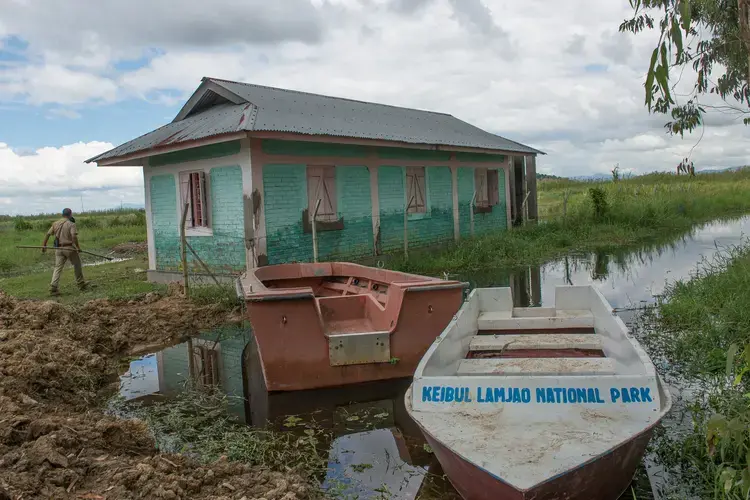
Loktak Lake is a unique wetland and is listed as a wetland of International Importance through the Ramsar Convention treaty. The lake is distinctive due to the numerous green floating biomass (phumdis) that covers nearly two-thirds of the lake’s 236 square kilometers.
Phumdis or floating islands are comprised of vegetation, soil, and other organic matter. They change shape and size, moving around the lake surface depending on the season. Thephumdis play a critical role in water cleansing, nutrient absorption, flood control, and carbon sequestration. Phumdis are home to some 425 species of animals, including the endangered “dancing deer,” over 100 species of birds, and over 200 species of aquatic plants.
Loktak Lake is home and means of livelihood to indigenous (Meiteis) families that live on Phumshangs. Some 30,000 fisher folks fish the lake. Over 100,000 people depend on the lake directly and indirectly for food and livelihood. The lake is of immense cultural, social and economic importance to some 55 communities that surround the lake. This photo essay documents how the Ithai hydroelectric dam, infrastructure projects, regional armed conflict and climate change threaten this unique ecosystem.

A view of Athaphums which are human-made fish culture ponds for shallow water fishing in Loktak Lake. After the construction of the Ithai Dam, water levels in the lake rose, severely impacting fishing in Athaphums. Consequently, some fishermen began using pesticides to kill fish; the practice has now declined.

Indrajeet Tombram (left) and Haobijam Manihar perform the backbreaking task of dredging out weeds that had proliferated on a fish farm in Loktak Lake. Increased erosion and use of fertilizer along with an altered hydrology due to the commissioning of the Ithai Dam have resulted in increased rates of eutrophication.

Ibomcha Singh examines his catch of Fabou nga (a native fish) that he fished using Burmese fishing net in Loktak Lake. The construction of the Ithai Dam altered the hydrology of the lake, impacting the breeding process of native fish species and changing fishing techniques. Numerous native fish species have disappeared from the lake.

Mukha nga (non-native fish) that were fished from Loktak lake sit in a basket at the Laishram family home in Thanga. After the construction of Itahi Dam when the native fish populations in the Loktak Lake began dwindling, the state fisheries department introduced numerous non-native fish species to the lake.

Ningthoujam Ongi Shanti poses for a portrait along with her granddaughter Baby Naidya in the village of Thanga, Manipur. In March 1999, the Indian Army conducted an anti-insurgency operation around Loktak Lake during which Shanti was wrongfully taken into custody by law enforcement. Areas surrounding Loktak have been used as hiding grounds by insurgent groups which have intensified the militarization of Loktak Lake.

Ibeton Devi uses a traditional fishing technique called El Khonbi to fish in the pond in her backyard. Many traditional fishing techniques meant for shallow water are disappearing after the Ithai Dam elevated the water levels of the lake.

Sonia Khwairaakpam visits the Laishram family home in the village of Thanga. Three weeks after Sonia gave birth to her son Malem, heavy rains flooded her home, compelling her family to move out of their home. Hydrological changes due to the construction of the Ithai Dam along with climate change have resulted in severe flooding unlike observed before.

Basant Salam, a forest guard at Keibul Lamjao National Park, walks past his guard shack with visible flood marks. This year the park remained severely flooded for weeks during monsoons, endangering wildlife and hindering patroling activities.

A government official delivers a speech at the 2017 Loktak Day celebration, emphasizing the conservation of the Loktak Lake. The 105 MW, Loktak Hydro Power Project, commissioned in 1983 for power generation and irrigation has not only been underperforming but has also resulted in an ecological disaster in the Loktak Lake and impacted the livelihoods of over 30,000 fisherfolks.

Vehicles drive along the dusty high road that circles the Lokta lake. The government wants to convert it to a paved ring road to draw tourists. Some local activists oppose the ring-road as well as several other tourism-related infrastructure projects that they consider threats to the wetland.

Fisherwomen and vegetable vendors wrap up business for the day in the Ema market in Ningthoukhong, in Manipur. Recurrent floods during monsoon season continue to impact fisheries and vegetable harvest in the area. In August 2017, the state Chief Minister Biren Singh formally urged Prime Minister Narendra Modi to consider the decommissioning of the Ithai Dam as a permanent solution to the ecological disaster.






